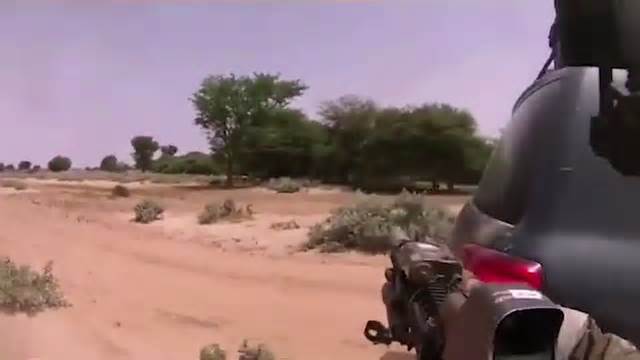9news.com
The creep of Islamic State’s evil tentacles into Africa and the rise of terror attacks in the continent by groups linked to ISIS and Al Qaeda is causing increasing concern to the US military and its allies.
Following Islamic State’s heavy strategic defeats in Iraq and Syria, the extremist group’s influence has now spread into Libya, Niger, Mali, north-eastern Nigeria and northern Chad.
With a new frontier forming in Africa, the war on terror, which began in September 2001, is showing no sign of ending soon.
Last month, General Thomas D. Waldhauser of United States Africa Command (AFRICOM) warned a strategy hearing in Washington that the terrorist threat in and from Africa will grow as ISIS is pushed out of Iraq and Syria.
Members of an Islamic State affiliate walk captured Ethiopian Christians along a beach in Libya, before being executed (AAP)
Terror groups currently “permeate the entire continent” in various locations, Gen Waldhauser, who leads the US military effort to combat threats to America and its allies in Africa, said.
“At the present time, [terror groups in Africa] really do not have the capability to conduct operations … in the United States, but they certainly aspire to do that.”
Somalian group Al Shabaab, which has been affiliated to Al Qaeda since 2011, and Nigeria’s Boko Haram, which has pledged allegiance to ISIS, are both key actors in Africa.
Africa’s vast and often ungoverned spaces, weak government, poor security and struggling economies make the region a ripe breeding ground for ISIS, Al Qaeda and others.
Gen Waldhauser said local African militia groups who affiliate with Al Qaeda and ISIS is likely to result in greater ambition to attack Americans in the region, Europe or mainland US.
Between January 2007 and December 2011, jihadists conducted 132 attacks against Western interests in Africa.
Damage after an airstrike by US warplanes against a jihadist training camp in Sabratha, Libya (AAP).
That figure nearly tripled to 358 attacks between January 2012 and October 2017, according to a February report by the policy think-tank Foundation for Defense of Democracies.
Last year more than 500 people were killed and 312 wounded after a truck bomb detonated in Mogadishu.
Though not claiming responsibility, a cell of militant group al-Shabaab was blamed for the horrific bombing in the Somalian capital.
In October, with the so-called Caliphate in Iraq and Syria in its death throes, ISIS supporters used online platforms urging Muslims to go to the “land of Jihad” in Africa.
Many jihadists fleeing Syria and Iraq have travelled to Libya, a nation which remains politically and militarily divided ahead of potential crucial elections later this year.
Nigerian soldiers man a checkpoint in Gwoza, Nigeria, looking for Boko Haram terrorists. (AAP).
The US military is currently engaging ISIS cells in Libya through a combination of its special forces and strategic strikes from the air.
Libya acts as a gateway to The Sahel, a region that spans the broadest part of Africa, from the Atlantic Ocean to the Red Sea.
ISIS and Al Qaeda are particularly active in parts of Niger, Mali, north-eastern Nigeria and northern Chad, which make up The Sahel.
In 2016, Australian doctor Ken Elliott was kidnapped by militants in northern Burkina Faso, which falls inside the western Sahel.
Dr Elliott’s wife, Jocelyn, pleaded in an online video in March for the group to release him, saying her husband did not have long to live.
Australian doctor Ken Elliott was kidnapped by Burkino Faso militants linked to Al Qaeda. Unclear if he is still alive, Dr Elliott has been held hostage in West Africa since 2016 (Supplied)
It has been more than two years since the 82-year-old was captured by Nusrat al-Islam wal Muslimeen, Al Qaeda’s branch in the African Sahara.
It is unclear if Dr Elliott is still alive. The former Perth doctor who ran a small hospital in Burkino Faso has not been seen since a proof of life video was released last July by his kidnappers.
While Islamic State has largely hogged the limelight over the past three years, Al Qaeda has been quietly rebuilding and established a leadership role for Osama bin Laden’s son, Hamza.
Analysts believe Hamza bin Laden is the new face of Al Qaeda, and he has released a number of propaganda videos in the last 12 months, including calls to avenge the death of his father.
Osama Bin Laden and Hamza’s brother Khalid were killed by US Navy Seals during a daring raid on their compound in Pakistan in 2011.
Osama bin Laden sits with his then deputy Ayman al-Zawahiri at an undisclosed location in Afghanistan (AAP)
A young Hamza bin Laden with his now dead father, Osama (60 Minutes)
Last week a Kremlin official estimated Al Qaeda’s monthly revenues to between $26m – $53m, dwarfing the reduced financial position of Islamic State.
Dmitry Feoktistov, deputy director of the Russian Foreign Ministry’s Department on New Challenges and Threats, told RT that Islamic State revenues were now just $4m per month.
In 2015, when Islamic State was near the peak of its powers, the group was estimated to be raking in $100m a month.
Al Qaeda is viewed by analysts to be a greater threat than ISIS, because of the group’s ability to plan for the long-term fight against the West.
FOLLOW: Mark Saunokonoko on Twitter








